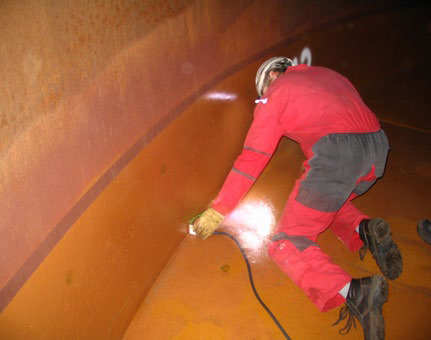Why Regular Tank Welding Inspection is Essential for Structural Integrity
Why Regular Tank Welding Inspection is Essential for Structural Integrity
Blog Article
The Essential Duty of Tank Welding Examination in Ensuring Structural Stability and Safety Compliance in Industrial Applications
In the realm of industrial applications, container welding assessment arises as a critical aspect in safeguarding structural stability and guaranteeing conformity with safety guidelines. Making use of a combination of techniques such as visual evaluations and advanced testing techniques, these examinations offer to identify and mitigate potential defects prior to they rise right into significant risks.
Value of Container Welding Examination

Making sure conformity with sector criteria and regulations is another significant element of storage tank welding inspection. Regulatory bodies mandate rigorous standards for the building and construction and upkeep of storage space containers, and thorough inspections help companies comply with these needs. Non-compliance can cause extreme fines, consisting of penalties and closures, additionally highlighting the requirement for extensive assessment procedures.
In addition, storage tank welding evaluation plays an essential duty in preserving operational performance. In summary, the importance of container welding evaluation exists in its capability to safeguard public wellness, safeguard the setting, and make sure compliance with regulative frameworks.
Trick Evaluation Strategies
Reliable storage tank welding inspection depends on a range of crucial strategies that make certain thorough examination of weld top quality and structural stability. Amongst the most prevalent methods are aesthetic inspection, ultrasonic testing, radiographic screening, and magnetic fragment testing - Tank Welding Inspection. Each technique uses one-of-a-kind advantages in evaluating various facets of the weld
Visual evaluation acts as the initial line of protection, allowing inspectors to determine surface area issues, abnormalities, or inconsistencies in the weld bead. Ultrasonic testing utilizes high-frequency acoustic waves to identify internal defects, such as fractures or spaces, supplying a thorough analysis of weld integrity. This technique is especially effective in identifying concerns that may not show up externally.
Radiographic testing makes use of X-rays or gamma rays to create pictures of the welds, exposing interior gaps and supplying an irreversible document for future recommendation. This method is highly reliable for important applications where the risk of failing have to be decreased.
Last but not least, magnetic fragment screening is utilized to determine surface and near-surface defects in ferromagnetic materials. By using magnetic areas and great iron bits, examiners can pinpoint discontinuities that might endanger the architectural you can try these out stability of the tank. Together, these strategies create a robust framework for ensuring high-quality welds in commercial applications.
Conformity With Safety Standards

Routine evaluations play a crucial function in guaranteeing conformity by determining possible failures or deviations from recommended standards. Examiners are educated to evaluate weld quality, verify material specifications, and evaluate the general structural stability of storage tanks. Their knowledge is essential in guaranteeing that welding procedures meet the needed safety and security criteria.
In addition, conformity with safety requirements not just safeguards employees yet additionally safeguards the setting from prospective dangers such as leaks or disastrous failings. Organizations that prioritize security conformity are much better placed to reduce threats, improve functional efficiency, and foster a society of safety and security within their workforce. In summary, preserving strenuous conformity with safety requirements is vital for the effective operation of storage tank welding tasks in commercial setups.
Advantages of Regular Evaluations
Routine examinations are indispensable to maintaining the structural stability and security of bonded containers. These examinations provide a systematic strategy to determining potential issues or weaknesses in the welds, ensuring that any type of issues are addressed before they rise into significant failings. By conducting routine assessments, organizations can find corrosion, exhaustion, and various other forms of damage that might endanger container efficiency.
Additionally, constant assessments add to compliance with market laws and criteria. Sticking to these standards not only reduces legal risks yet also improves the company's credibility for safety and security and integrity. Routine evaluations foster a proactive safety and security society, motivating employees to recognize and focus on the relevance of equipment stability.

Instance Studies and Real-World Applications
Case research studies and real-world applications highlight the tangible effect of reliable tank look at here now welding evaluation practices. Following the implementation of strenuous welding evaluation procedures, consisting of visual and ultrasonic testing, the facility recognized critical defects in weld joints that could have led to disastrous failures.
In a similar way, a water therapy plant executed a thorough evaluation program for its tank welding operations - Tank Welding Inspection. By including non-destructive testing approaches, the plant was able to find very early indications of deterioration and fatigue in weld joints. visite site This prompt intervention prolonged the life expectancy of the storage tanks and made sure compliance with security regulations, thus protecting public health and wellness
These situation research studies highlight the value of normal and organized storage tank welding inspections. By focusing on these techniques, sectors can minimize threats, boost architectural honesty, and make certain conformity with safety requirements, eventually bring about improved operational efficiency and reduced liabilities.

Conclusion
In final thought, storage tank welding evaluation is a vital component of keeping structural honesty and security in industrial applications. Using various examination strategies makes sure very early discovery of prospective imperfections, thus protecting against devastating failings.
Report this page